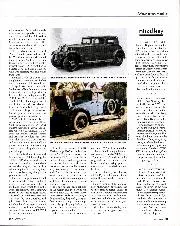
A Press handout
A Press handout from Castrol UK informs us that David Beckham says, "It is exciting to be working with Castrol". For more years than I like to admit to I…
Motorcycling’s world championships celebrate their 70th birthday in June. The first racing season that awarded world titles ran from June to September 1949, taking in rounds on the Isle of Man, at Bern, Assen, Spa-Francorchamps, Clady and Monza.
In fact, that’s not strictly true: the first ‘motorcycling track championship of the world’ took place at a 1903 cycling event in Paris. But this doesn’t really count, as the event was contested by Frenchmen riding French motorcycles around a French track. The winner was Maurice Fournier, riding a 1500cc V4, manufactured by Clément Cycles.
Plans for the creation of the world championships were first discussed at a FICM (Fédération Internationale des Clubs Motocyclistes) meeting in Italy in April 1946, eight months after WWII. The leading light in these talks was Count Giovanni Lurani, who also worked with the FIA, initiating GT racing.
Motorcycle racing changed significantly as a result of the FICM meetings, which concluded at the RAC club in London in 1948. The supercharged machines that had dominated racing in the late 1930s were banned, because the only available ‘pool’ petrol wasn’t up to the job. Everyone had to drastically reduce compression to suit the 75-octane fuel, which Norton technical director Joe Craig declared “little better than paraffin”. German riders and manufacturers were also banned, so no BMW or DKW, which had been major pre-war forces.
Four manufacturers contested the premier 500cc class, the only category that ran at all six rounds (supported by 350s, 250s and 125s): Norton, AJS, Gilera and Moto Guzzi. Except that Gilera didn’t turn up for the first race on the Isle of Man, because the expense of a two-week event 1200 miles and two boat rides away was too much in those hard times.
The Senior TT – 264 miles of hellishly bumpy 1940s Manx roads – was dominated by RAF pilot Les Graham, until his AJS broke its magneto with less than two miles to go. Thus Harold Daniell became the first winner of a premier world championship race, on an updated pre-war factory Norton single.
Round two was hosted by the city of Bern, around the lethal Bremgarten circuit. Gilera arrived in force, with its four-cylinder Quattro, much-changed since it won the 1939 European championship in supercharged form. Ferrari was also present with its first F1 car, the supercharged V12 125. Ferrari’s Alberto Ascari won the car race, while Graham and AJS took victory in the bike event, ahead of Gilera’s Arciso Artesiani and Norton’s Daniell, who kept his place at the top of the championship.
Artesiani’s team-mate Nello Pagani won next time out at Assen, after a last-lap dogfight with Graham, who took the championship lead. The following weekend at Spa a split fuel tank did for Graham, which put Pagani ahead. It didn’t matter. Graham ran away with round five at Clady in Northern Ireland, where the seven-mile straight was so bumpy that the Gilera riders couldn’t use full throttle to exploit their top-speed advantage.
“Gilera didn’t turn up due to the expense of a 1200-mile trip”
Les Graham was now world champion, with his best three scores already unbeatable. Pagani won the finale at Monza, leaving him one point behind Graham in the riders’ championship and Gilera just one point behind AJS in the constructors’ championship.
Norton won the crown two years later, the last British marque to win a premier-class world title. The British industry seemed overcome by post-war lethargy, with AJS directors refusing the budget to improve the E90 Porcupine (nicknamed for its spiky engine fins) and Norton management unwilling to move beyond its unstreamlined single-cylinder machine, because that’s how the company sold its road bikes.
Gilera assumed dominance in the next few years by redesigning the Quattro’s chassis, copying many features already used by AJS and Norton; its girder front forks and friction rear dampers were replaced by hydraulic forks and rear shocks. As soon as Gilera riders had the handling to match their horsepower there was no stopping them.
Frustrated by Norton’s reluctance to progress, Geoff Duke signed with Gilera in 1953 and won motorcycle racing’s first world-title hat-trick. British riders were a favourite with Italian brands for the next decade; MV Agusta signed Graham in 1952 and four years later lured John Surtees away from Norton.
Germany was allowed to race from 1952 finding success in the smaller classes, but in 1955-60 the Italians asserted their dominance, winning all 24 constructors’ titles.
In 1959 the series moved into its next phase, when Honda turned up on the Isle of Man. The company won its first world titles two years later and was quickly joined by Yamaha, Suzuki and Kawasaki. By the mid-1970s Japanese manufacturers had all but taken over, a situation which continues today, although Spanish, Italian, German and Austrian manufacturers have also enjoyed occasional days in the sun.
At the end of the inaugural 1949 season the federation’s British representative claimed that the FIA was inspired by motorcycling’s example to create drivers’ and constructors’ categories for Formula 1’s first season in 1950.
Mat Oxley has covered motorcycle racing for many years – and also has the distinction of being an Isle of Man TT winner
Follow Mat on Twitter @matoxley